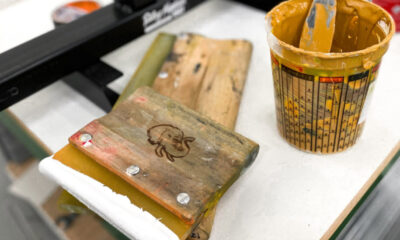Inks & Coatings
Published
22 years agoon
One of the least favorite places on the planet for every printer, and the one that holds the most potential for disasters, is the inkroom. Usually, it is the most neglected area in screen-printing shops. Ink is the basis of every job we produce, so we tend to keep a lot of it around. We generally stock our inks in a range of colors that we use to mix PMS colors or to modify stock colors in order to meet the customer’s requirements.
One of the least favorite places on the planet for every printer, and the one that holds the most potential for disasters, is the inkroom. Usually, it is the most neglected area in screen-printing shops. Ink is the basis of every job we produce, so we tend to keep a lot of it around. We generally stock our inks in a range of colors that we use to mix PMS colors or to modify stock colors in order to meet the customer’s requirements. Whether we use UV or solvent-based systems or both, chances are that we stock different ink colors from different manufacturers to print on the kazillion substrates our applications call for. Organizing this collection of inks is a challenge in and of itself. But the real problems begin when we start modifying our inks and center on what we put in those inks and how we monitor and control those additives. My purpose this month is not to define or tell you when and why to put additives in ink, or even what additives to use. There is probably more opinion and controversy about these issues than about the Battle of Little Big Horn. Instead, I want to focus on avoiding ink headaches through good research and record keeping. All mixed up To address printability, flow characteristics, adhesion, and other ink-performance issues, we use reducers, retarders, thinners, adhesion promoters, bases, flow agents, and similar modifiers. The typical way we use these additives begins with a phone call to the ink manufacturer. For example, if we have trouble getting an ink to adhere to a substrate, we call the ink manufacturer to find out if this or another ink is compatible with the substrate or if there is something we can add from our collection to make the ink stick. What we get it response is usually several options, rather than one definitive solution. We love options, right? When we get them, it’s kind of like jumping out of an airplane and deciding which way to fall. The fact that we have options means we have to make choices. And the burden of making the right decision falls on our shoulders. Maybe we should do our homework a little better. I remember in a past lifetime printing a job that involved nylon jackets. I remember what a painful application this was because of the way the ink refused to adhere to the jackets. I remember all the "excuses" I got from the ink manufacturer, which I didn’t really didn’t buy–some garbage about a waterproof coating on nylon and testing the fabric before printing. So I changed ink manufacturers and the new ink I started using seemed to work great for awhile. But the prints soon started to peel from the material. I called the new ink manufacturer, only to hear some more garbage about waterproof coatings and testing. Eventually I started listening, though. I learned to pay attention when I bought jackets. I made sure I knew what was on them, then tested to make sure I had an ink that would work on the material. Now, I’m all grown up and print on all kinds of material. I have to consider dyne levels, surface tension and energy, corona treating, web direction of the material, plasticizer content, whether the material is cast or calendered, and lots of other fun stuff. But sometimes, I still run across jobs in which the ink just flakes off the substrate or won’t dry or cure. And when I call my ink supplier about the problem, guess what he says? "It’s the coating." Back to those darn options again! To be fair to the manufacturers, I must add that there is no possible way they can cover all the bases and provide inks that work perfectly on every material–there are just too many variables involved with our substrates. And when we throw in the press variables that affect ink deposit and influence ink performance, it’s a wonder that ink suppliers don’t include legal disclaimers with every bucket they ship. The best we can do is learn all we can about the materials we are printing, then use personal experience, guidance from manufactures, and testing to explore which of the ink-modification options gives us the best results. Smart and dumb ink buckets Figuring out how to modify our inks is only half the battle, though. The second part introduces another problem, one I like to call the "smart and dumb ink-bucket variable." What’s the smart/dumb bucket variable? It’s something I’ve learned the hard way. We all get in a hurry to get jobs out the door. So when a job is on press and we realize the ink isn’t sticking or won’t sheer or flow properly, we make hasty modifications and just pour in some magic elixir–whatever modifier(s) we feel are appropriate. How much do we add? Let’s see, was that 10% by weight or volume? Oh well, they’re probably the same anyway, right? Now we have a bucket of ink to which we’ve added something in some quantity. What and how much is anybody’s guess. And what do we do when the job is complete? Most likely, we place the bucket back on the inkroom shelves. Now here’s a critical question: Did we mark the bucket with information about what we added, how much we added, and when we added it? We better hope so. Otherwise, next time we need this ink type or color, we may unwittingly grab that same bucket. And what happens if we get adhesion or flow problems on this job. We add modifier again. But wait, we just added 10% modifier to an ink that already had 10% modifier. Now we have an ink that won’t work at all. This happens in plants more than I want to talk about. I was in one company where printers kept cups of silicone at press side. They added this to the ink on press as a flow agent to get rid of bubbles in the ink. It got rid of the bubbles, alright. And when they were done printing, the excess ink was removed from the press and put back in the bucket. I wondered how many printers used that bucket and how many times silicone had been added. It was anybody’s guess. So why was I in this plant in the first place? To troubleshoot why they were having problems placing laminating adhesives and premasks over their inks. Mmmm? Think the silicone could have something to do with it? This is what I call a "dumb bucket" situation. It doesn’t take much imagination to figure out why. If we add something to an ink, we need to record it somewhere on the bucket! If you use masking tape for your label, I suggest you stick this somewhere over the existing manufacturer’s label, but not over any important information on that label (the tape probably won’t stick to the plastic bucket itself). This brings up another point. The labels on your ink buckets need to be legible, whether they are the manufacturer’s labels (which typically contain lots of useful information) or ones you’ve added to record modifications. Do you know how many shops I’ve been in where I’ve found that you can’t read labels on ink containers. Once again, we have dumb buckets! I’d like to make a simple suggestion to avoid this problem–pour ink out on the other side of the container! Final thoughts In all the plants I’ve managed, I never allowed printers to add anything to inks in the first place. That’s what we pay people in the inkroom to do. And if our ink people add something, they mark the modified container with all the pertinent details. Furthermore, we recorded modifications on our work orders, including what we added, how much, the type of ink we modified, and the parameters for curing it. I realize not all shops have ink matchers or personnel dedicated to ink. But it takes only a couple of minutes write the information on a piece of tape and put it on the bucket. Those two minutes won’t cripple production. A dumb bucket will.

Subscribe

Magazine
Get the most important news
and business ideas from Screenprinting Magazine.
Most Popular
-

 Case Studies2 months ago
Case Studies2 months agoHigh-Density Inks Help Specialty Printing Take Center Stage
-

 Art, Ad, or Alchemy2 months ago
Art, Ad, or Alchemy2 months agoF&I Printing Is Everywhere!
-

 Andy MacDougall2 months ago
Andy MacDougall2 months agoFunctional and Industrial Printing is EVERYWHERE!
-

 Columns3 weeks ago
Columns3 weeks ago8 Marketing Mistakes Not to Make When Promoting Your Screen Printing Services Online
-

 Editor's Note3 weeks ago
Editor's Note3 weeks agoLivin’ the High Life
-

 Marshall Atkinson3 weeks ago
Marshall Atkinson3 weeks agoHow to Create a Winning Culture in Your Screen-Printing Business
-

 Thomas Trimingham2 months ago
Thomas Trimingham2 months ago“Magic” Marketing for Screen Printing Shops
-

 Case Studies3 weeks ago
Case Studies3 weeks agoScreen Printing for Texture and Depth





